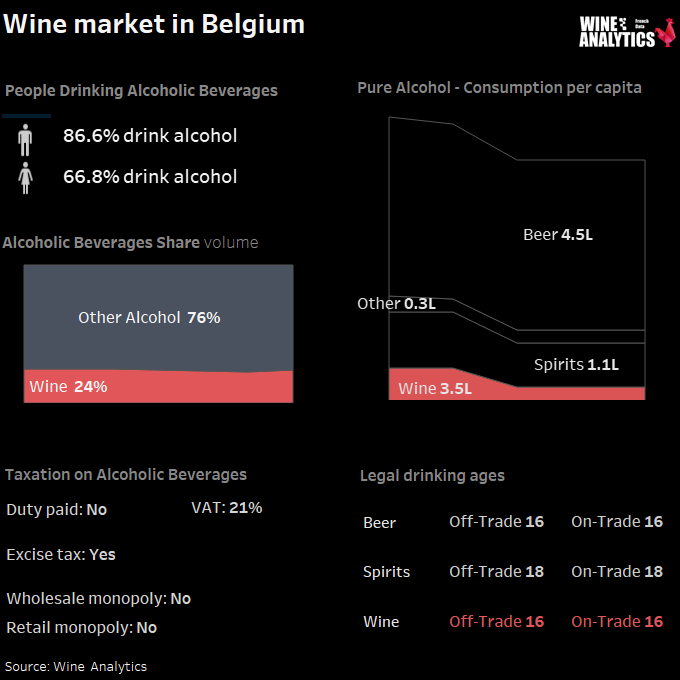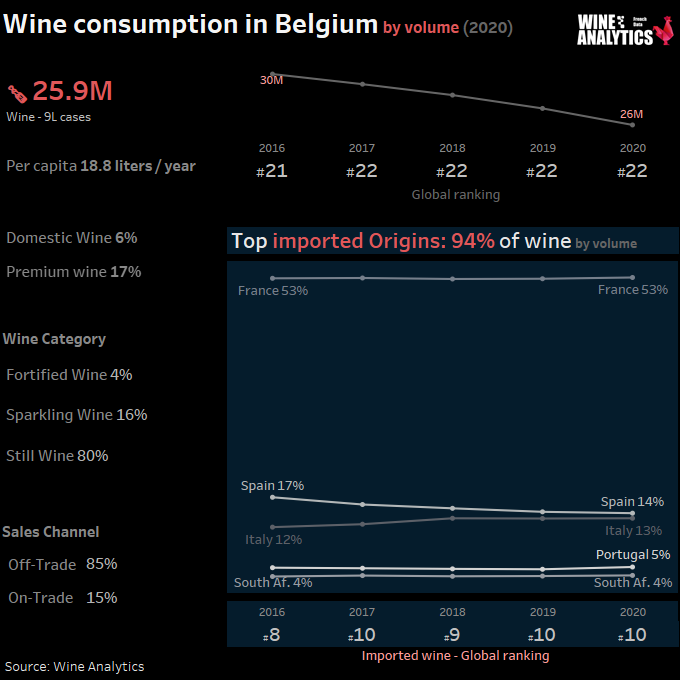Belgium enjoys one of the highest per capita incomes in Europe. It has a complex federal political structure. Political divisions between Dutch-speaking Flanders in the north and French-speaking Wallonia in the south have led to constitutional amendments granting these regions formal autonomy. The Brussels-Capital Region is an officially bilingual enclave within the Flemish Region. A German-speaking Community exists in eastern Wallonia.
RATE THE BELGIAN WINE MARKET ATTRACTIVENESS
The Belgian economy is heavily service oriented and shows a dual nature with a large economic gap between the Dutch speaking Flanders region in the north, and the French speaking Wallonia in the South. While Flanders is very trade-minded, Wallonia tends to mimic France’s positions.
Read also Switzerland, How Consumers Choose Wine

The On-Trade Market
Consumption of food products in Belgium mostly happens at home, but the food service market in Belgium features a very high number of independent outlets in all of the main categories, such as full-service restaurants, fast food, café and bar has been difficult for independent foodservice operators, as they face both tightening fiscal legislation and increasing competition from more modern and dynamic concepts, especially in fast food, full-service restaurants and cafés/bars.
In 2018, there are about 58,391 outlets in Belgium, of which 34,102 in Flanders. About 54% of these in Flanders are restaurants. In Belgium, there is a tendency to serve both drinks and food, compared to neighboring countries where there is usually more interest for solely drinks in these establishments based on consumer demand or preferences.
The Retail Market
In terms of market share, large supermarkets represent 50% of annual revenue of the Belgian food retail sector, medium-sized supermarkets represent 30%, small retailers/convenience stores represent 5%, and hard discounters represent 15%.
The Belgian retail market is fairly consolidated. Eight different international groups dominate the Belgian retail market and represent 92% of the market share.
| Retail actors |
| Ahold Delhaize Group |
| Carrefour Group |
| Colruyt Group |
| Louis Delhaize Group |
| Lidl |
| Aldi |
| Intermarché |
| Metro Group |

Domestic beers vs. imported wines
Belgium is a country with numerous breweries and different beers. Nowhere else in the world can you encounter so many local, authentic and colorful beers with such an enormous range of tastes and flavors. While there are only 12 Trappist beers in the world, 6 of them have a Belgian origin and are brewed by the monks in abbeys. 85% of Belgians of drinking age say they drink beer at least occasionally. This market segment leaves very few opportunities for foreign supply, as the local supply is so developed. There are more than 300 breweries in Belgium and imports are very low.
The consumption of wine is very culturally rooted
Belgium has 11.5 million inhabitants, of whom almost 75% buy wine for home consumption, 12 times a year on average.
For wine, although the value of imports has increased compared to last year, the volumes have been decreasing for several years. Belgians are consuming better quality wines. The most popular price range is between EUR 5 and 8.
The Belgian market is a historical market, and wine consumption is very culturally anchored. Red and white wines are the most popular. Rosé wines come in third place, and are consumed more by the younger segments of the population and in Wallonia.

Which supplier French wines are very present on the Belgian market, however they are losing ground and are less and less dominant in Belgium. French production is still the most popular, but Spanish and Italian wines are the main competitors, taking more and more market share.
The main competitors are the Spanish and the Italians who offer products with good taste qualities and a good price/quality ratio. The Belgian consumer is also becoming more and more open to New World wines, in particular Chilean wines. Belgium is an extremely important beer producer with a very positive import-export balance.
The average price of French wines : French wines are present in all price ranges.
The leading wines in Hypermarkets in 2021
Nielsen figures released by Carrefour Belgium show that Belgians increased their consumption of all types of wine between August 1, 2020 and July 31, 2021. The increase in sales is generalized to all mass-market retailers, with gains of 10% for red wine sales (48% of sales), +8% for whites (35%) and 10% for rosés (17%). Champagne jumped 30%, while Prosecco was up 21%.
In terms of origins, Delhaize sees Australia and Spain as the big market share winners in all colors in its stores, while in reds, Argentina and Chile are making particular progress.
For whites, France is well placed with gains for Rhône, Bordeaux and Alsace. Finally, in rosé, Argentina, Greece, the Loire and Alsace recorded gains in market share, with overall rosé sales increasing at Delhaize, despite the rather gloomy weather last summer and no doubt thanks to the increased deseasonalisation of its consumption.

Delhaize offers various wine containers
In a context marked by a boom in wine sales in Belgium, Delhaize is following a trend among Belgians to vary containers. Starting with bag-in-boxes, whose sales at Delhaize are up this year by more than 15% compared to last year, which was already characterized by a very strong increase.
Small formats are also on the rise, with over 150,000 small bottles sold this year. At the same time, more original containers are on the rise. This is the case for pouches, which are becoming more and more popular, with more than 400,000 units sold this year. Delhaize intends to promote this format by marketing, among other things, a Côtes de Provence rosé in a pocket, to play on the “over-value effect”. But the big news this year in terms of packaging is the recycled cardboard bottle, which makes its appearance with a new Spanish wine, “Planet B”, both vegan and organic. The bottle weighs only 83 grams, five times less than a traditional glass bottle.
Work with different importer by region
It is advisable to work with an importer. The importer will be able to facilitate the distribution of the wine on the territory and will eventually take part in the administrative procedures relating to excise duties. Belgium has about 800 wine importers, most of which are located in Flanders. It is generally better to work with an importer in Wallonia and another in Flanders for both wines and other types of beverages.
Meeting the importer is essential, it is good to keep a regular link with the importer. It is also necessary to also adapt your approach to the Belgian culture. It is important to remain pragmatic. Even though it is easy to get used to being on first-name terms, it is important not to get the wrong idea.
Unlike food products, wines and other alcoholic beverages are not subject to dual labeling in French and Flemish. In addition to facilitating transportation, this new packaging has a carbon footprint that has appealed to the distributor.